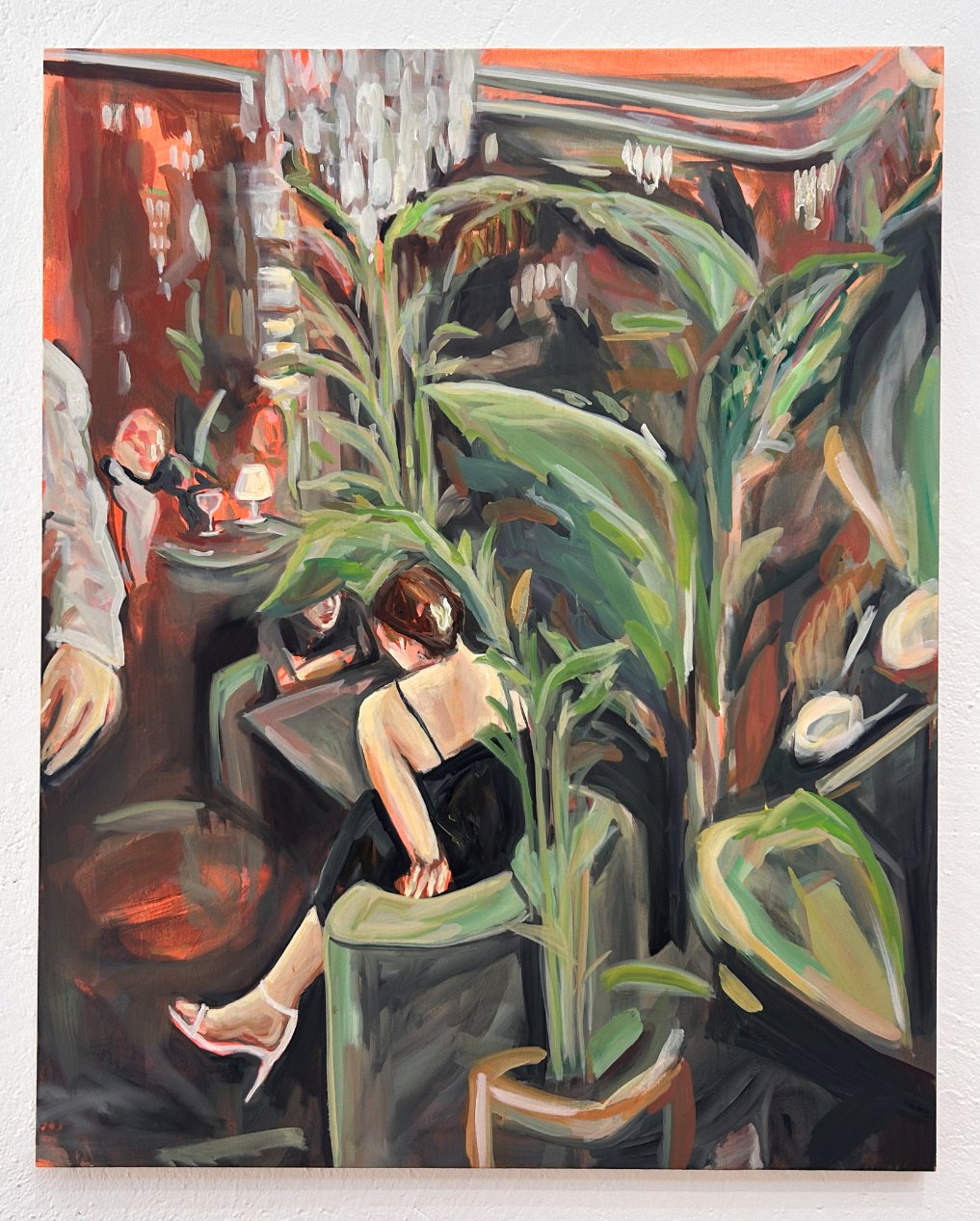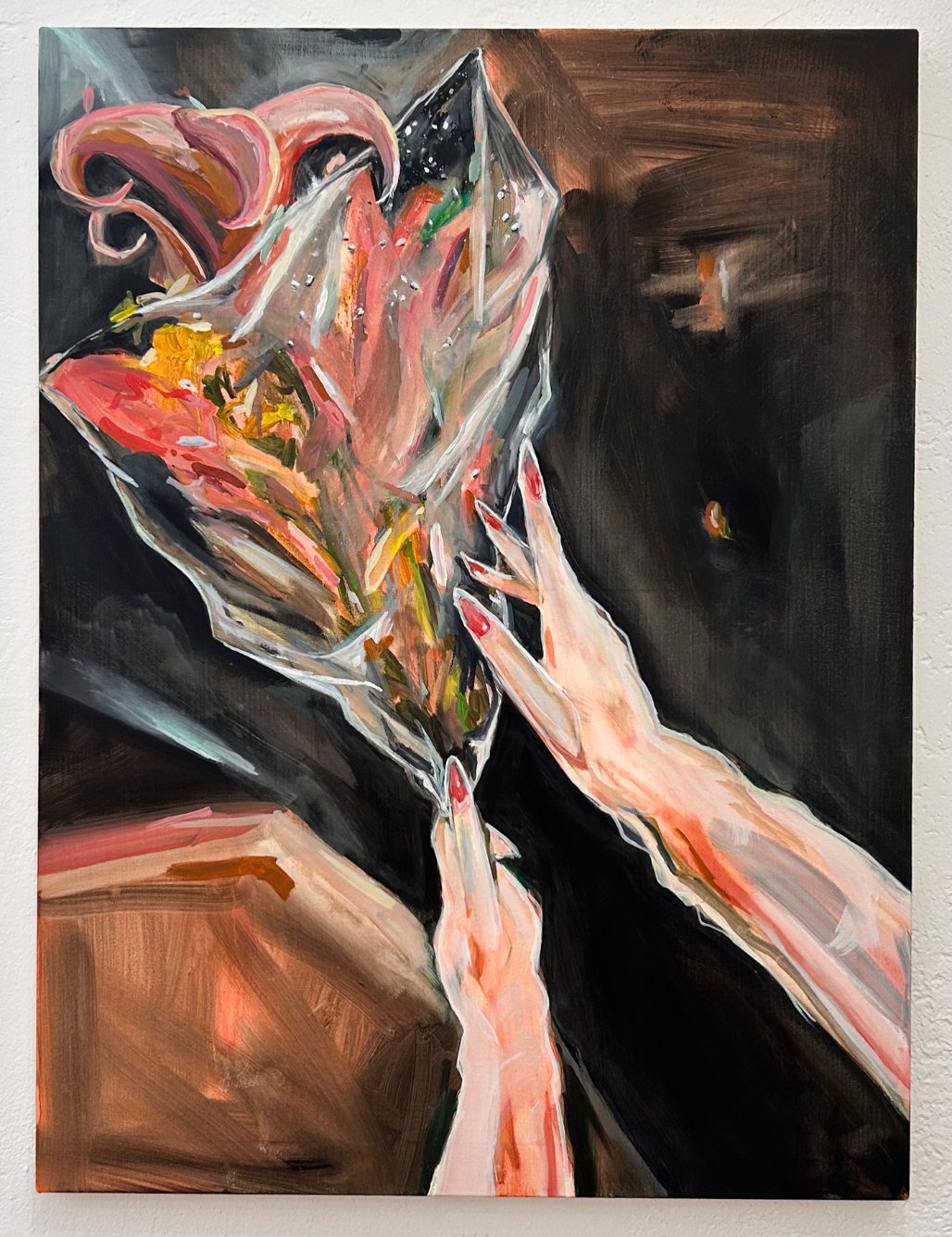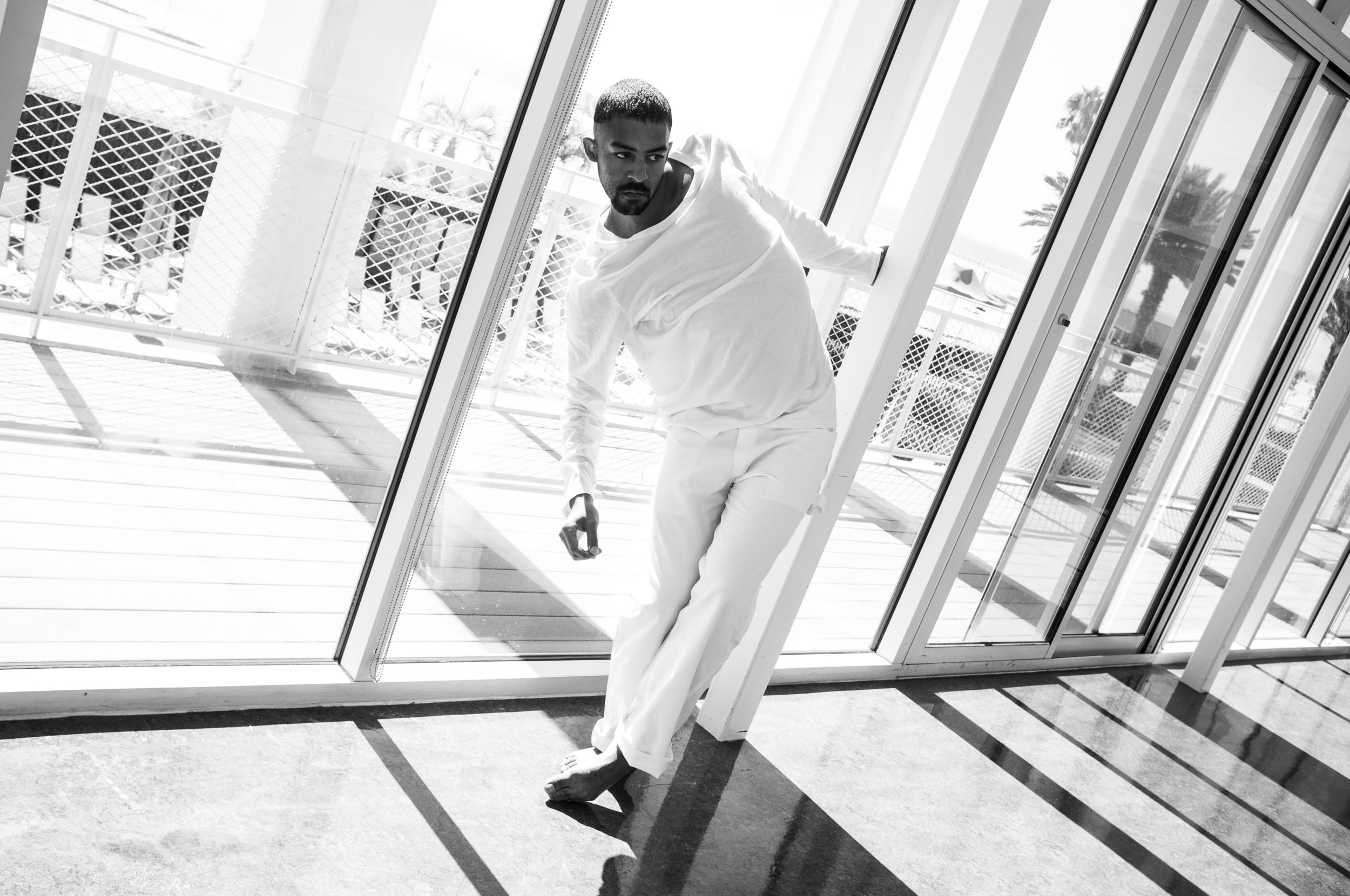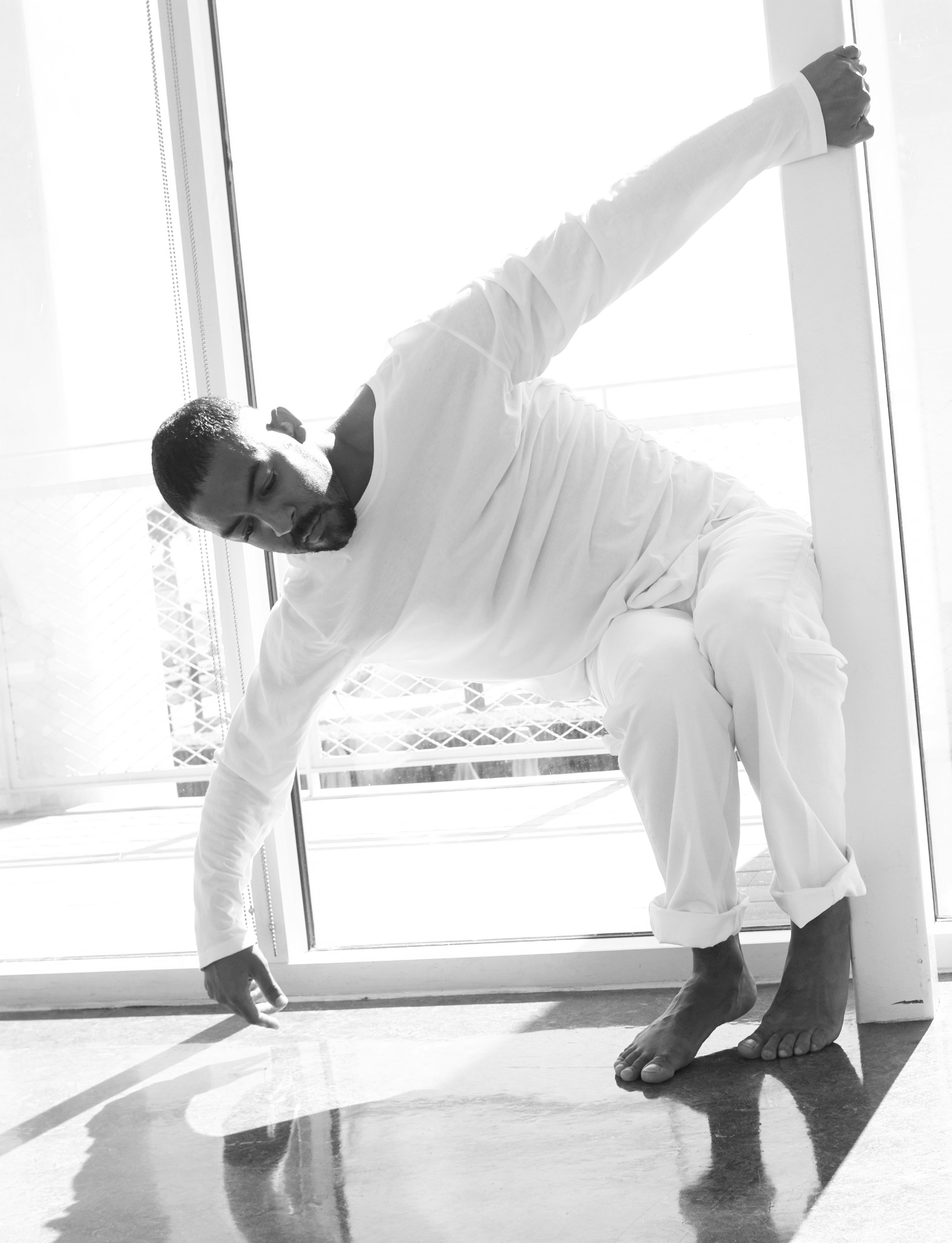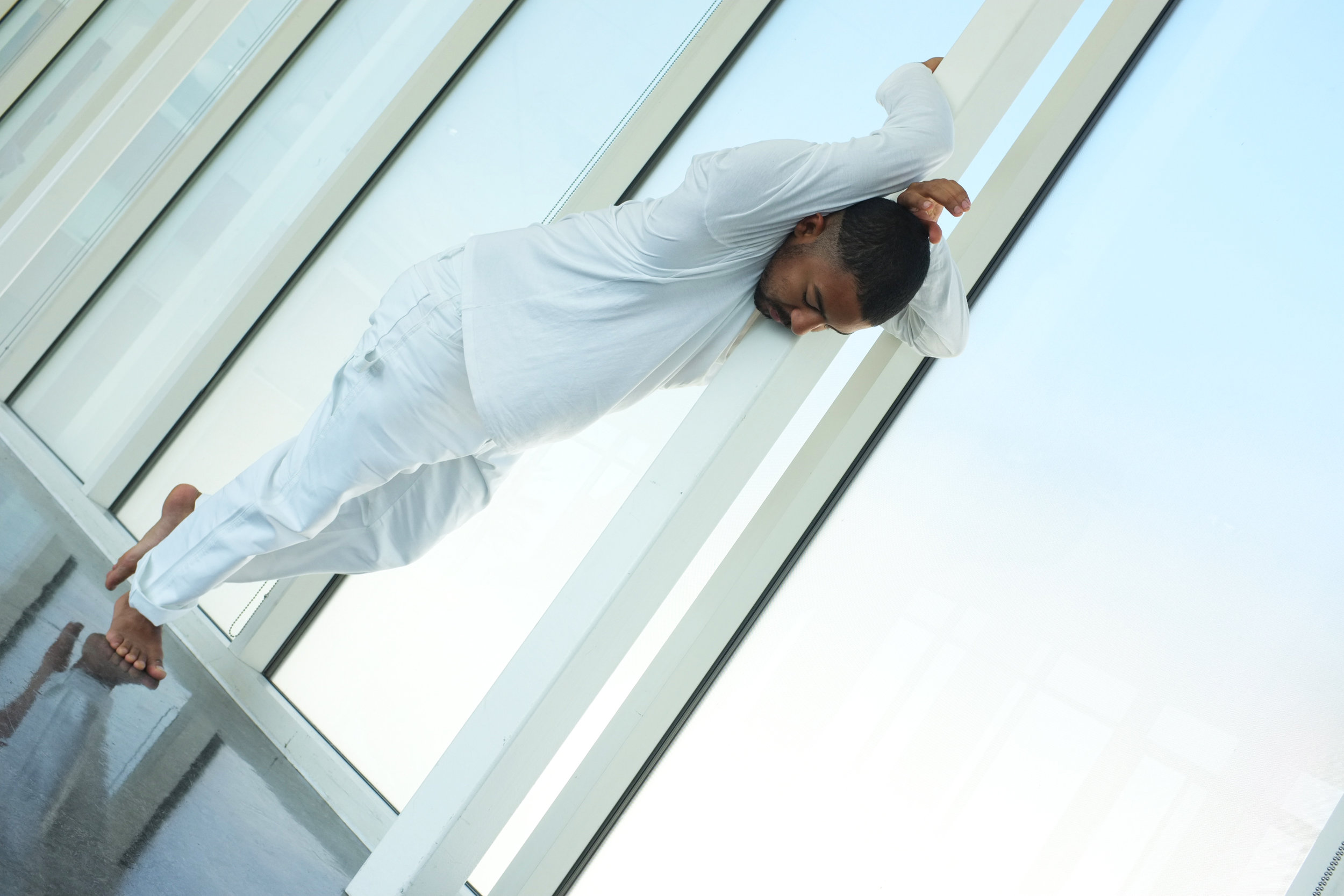text by Summer Bowie
In utero, all of our body’s desires are met by the host body we inhabit. Upon our emergence into the world, we find ourselves still dependent on this body that we cannot yet distinguish as separate from our own. When we suckle our mother’s breast, a hormone called cholecystokinin is released into the intestine, which is responsible for satiety and sleepiness. Without it, we feel a novel, existential pain called hunger. And when its reserves are particularly low, our eyebrows turn red, our fists clench, and finally we discover our voice. Our bodies communicate their desires to our mothers as a mechanism of the survival instinct that we depend upon until we are capable of verbalizing them. This basic, primal lexicon that defies cultural distinctions is one aspect of Bachzetsis’ practice that I find most compelling. Conversely, her investigations into the gendered gaze, the performance of identity, and the appropriation of gesture give the work a fractalized complexity that exponentially opens new windows of inquiry into the kaleidoscope of human impulse.
SUMMER BOWIE You're both a visual and a movement artist. How did you know that both these mediums would be the basis of your career?
ALEXANDRA BACHZETSIS I have been a dancer since I was a child. It was always my first passion. To respond with the body is super instinctive. It’s what you learn from childhood—even people who are not performing artists respond with their bodies. At the same time, I was starting to draw a lot. I studied visual arts in high school. But dance was always there simultaneously.
BOWIE And you play a lot with different forms of movement that are not often viewed on the proscenium stage: folk dance, athletic movement, very pedestrian movement. Where did your training get started?
BACHZETSIS I started with classical ballet at around four years old. I trained a lot in acrobatics, and I went to a physical theater school that was very circus focused. In the beginning, I wasn’t so sure how my career would evolve. But I felt like the contemporary dance field was more open for change than the contemporary circus field at that time. In contemporary dance, I could integrate different themes, physicalities, and body practices. My own practice has been equally situated in the visual art context and the theater context from the beginning. I focus on what the piece is about or where the research of the work leads to. I'm particularly obsessed with where movement comes from—which gestures are inherited versus those trained and learned. I was always interested in the legacies of the radical performance artists from the ’60s and ’70s, such as Yvonne Rainer, Yoko Ono, Trisha Brown, Valie Export, Carolee Schneemann, Simone Forti, Bruce Nauman, and Bob Fosse.
BOWIE Postmodernists like Yvonne Rainer and Simone Forti were so adamantly anti-virtuosic—yet you tend to incorporate both virtuosic and pedestrian movement so fluidly.
BACHZETSIS When I started professionally dancing in the mid-90s, most contemporary choreographers and performers worked around the idea of rejecting dance. It was all about thinking before you move. That slightly forced cerebral approach made me realize there were other modes of expression necessary to integrate into a dance practice. I wanted to free myself from the dominant mood of that time. I started to investigate more passionate or lustful journeys of adapting movement, being physical, or thinking of physicality in general. My first solo piece, entitled Perfect, was both an attempt at virtuosity and abandoning virtuosity at the same time. In this piece, I formulate a loop of excessive fitness routines borrowed from gestures belonging to the ballet vocabulary, the fitness studio routines, the kung fu practice, the disco dance floor, the catwalk, and the rehearsal studio. As I repeat each section, the movements evolve and transform slightly, almost an invisible accumulation of gestures and attitudes. In the rigor of things, transformation can take place. In 2001, for Perfect, I was looking at how the virtuosic could be combined with questions of emotionality and physical endurance. But I was also attempting to formulate a score for female empowerment, working through the blood-sweat-and-tears nature of show business and the construction of the perfected image of a body, toward a different, more daily gestured version of self.
BOWIE Your use of repetition, or accumulation, and the connection you draw between automatism and eroticism is really interesting.
BACHZETSIS I always wonder why certain genres or types of dance are judged inferior. Why is ballet praised while pole dancing, or stripping, is considered vulgar? What I do is try to balance these disparate dance practices by appropriating them, studying them, training in them, repeating them infinitely, and making them my own. So, for instance, the erotic of stripping becomes very physical, almost acrobatic, while the grace of ballet loses its idea of sublime in the gradual deconstruction.
BOWIE Right, these hierarchies are sort of arbitrary, but they don't come from the movements themselves.
BACHZETSIS No, they come from the history of Western culture and judgmental Western society.
BOWIE I want to talk about the formation and expression of desire. You talk a lot about the way that our desires are a product of social conditioning. How do we know which aspects of our desires are unique to us as individuals, and which ones are a product of conditioning?
BACHZETSIS Maybe it's interesting to think about motherhood—when you have to feed a child. We come into the world hungry. The biggest desire is to feed and to survive. At the same time, young children are eager to get in trouble and throw themselves out of windows (laughs). As a mother, you must constantly figure out how to save these humans from killing themselves. So, it's a paradoxical function you undergo as a woman: having your own agency and then having to be there for someone else. And I feel those questions are very much related to the primer of desire: how do I shape codependency and become something for somebody else to exist? My whole performance practice is like that. I can’t perform without an audience, and an audience will receive nothing without me. There is also this feeding on what you need in order to construct this idea of desire. For me, these impulses are instinctive.
BOWIE You explore this a lot in the piece, Private: Wear a mask when you talk to me, which you did in 2015, before Covid.
BACHZETSIS That piece I created in dialogue with Paul B. Preciado. We were asking questions about privacy and exposure, the appropriation of other bodies, and the performance of masculinity. It also went into how others see you—not the way you are, but the way they imagine you. The title is also related to intimacy: how can we truly be addressed, or address someone else, maybe not when being exactly oneself, but an idea of the self in the eyes of the other?
BOWIE You work with a lot of popular music and costumes that harken popular archetypes, but then you establish a sort of individualized dialect with the movement. Would you say that this individualized flourish is our most honest expression of individuality?
BACHZETSIS Context is everything when it comes to the flourish. When something makes sense, it usually has to do with who is listening, who is watching, and who the dialogue partners are. These elements are in a certain dynamic with one and another. I don't feel we can think of ourselves as individuals with a singular pleasure—it's a singular pleasure rehearsed with another individual.
BOWIE You've worked a lot with Paul B. Preciado. How was that relationship established?
BACHZETSIS Adam Szymczyk, the artistic director of documenta 14 invited Paul to curate the public programs for Athens and Kassel, and Paul was also assigned to me as research curator for the work I was developing for the exhibition in both cities. That’s when we started working on the diptych, Private: Wear a mask when you talk to me, and Private Song. Later, we continued the collaboration for Escape Act. For that piece, Paul offered me a poem as a score entitled Love is a Drone. He generated this poem in dialogue with an artificial intelligence. I used the poem, an excessive pornographic vocabulary culled from the internet, in alphabetic order, to create and rearrange pop songs and rap songs that we reformulated, staged, and performed during the performance.
BOWIE Escape Act very interestingly addresses identity and the way that we can feel caged by our identities—particularly the way people project an identity onto us. Have you found that this is something you struggle with? Or is that something you feel confined by?
BACHZETSIS I struggle with a permanent judgment and interpretation by other people of my persona and my background. Growing up with a mixed cultural background has been quite a strange journey of feeling othered because of your origins and looks, and feeling exposed as exotic fetish simultaneously. The fact of being a woman, identifying as such, being super feminine, but also at the same time very athletic and physical in a liberated manner that is conventionally reserved for men, triggers a lot of criticism, sexual patronizing phantasies, and jealous adoration in people.
There are all these conditions of entrapment that society puts on the body. Desire gets commodified in multiple ways. First, it’s the status, the looks and the attitude, then the talent and the knowledge, and finally the function and duty. As a woman who isn’t forever twenty-five, as an artist and as a mother, I do get a lot of irritating comments about my still existing physical practice and my intense stage choreographies. As if one represents a threat to society when enduring a physical practice. In my work, I formulate identity as a playground of possibilities for a different future. A possibility for freedom of expression, freedom of body, freedom to touch.
BOWIE Dorota Sajewska wrote about your work, saying, “The body becomes a physical archive of other bodies.” Do you think that muscle memory is an instinct that functions as a way of archiving that which is most ephemeral?
BACHZETSIS Yvonne Rainer in her best-known dance, Trio A (1966), explores a simultaneous performance by three dancers that included a difficult series of circular and spiral movements. It was widely adapted and interpreted by other choreographers. Muscle memory, or physical memory, is crucial while dancing. It’s also very interesting how it conditions the movement patterns in relation to an architectural space and how architecture is perceived through the visiting or inhabiting body. Dance happens where bodies remember how to perform in space. If you revisit a space later, your body may not remember, but as soon as you put your body into the space, into the same conditions, and sometimes even the same angle, you immediately understand what it was. So, there is something like body memory for sure, which is intelligent and hidden; we don’t rationally understand it. These are interesting problems that are related to dance. When you train your whole life to remember steps or to remember how to evoke and affect emotion, or how to present a certain repetition of a theme, and those emotional landscapes are not forgotten—you carry them with you.
BOWIE Can you talk a little bit about the contradiction between intuition and gesture as it was explored in your piece 2020: Obscene?
BACHZETSIS This piece works with explicit language, explicit gestures, explicit violence, explicit erotic tension and beauty, and exaggerated male and female roles. And it asks questions about archetypical behaviors, gestures, and patterns, which are recurring elements in the history of body. The performers in the piece do everything intuitively as themselves, working on specific characteristics as elements of language, not so much on construction of a particular character. It's this game of going in and out of characters that makes the performer intuitively feel what is needed and how much of what to offer. So, it's a very demanding score—you must physically and emotionally engage fully all the time; yet at the same time, you're never playing a role.
BOWIE Working with those extremes, do you find that you need to establish boundaries, or safe words, with your actors when they work together? Or is there a certain level of trust established?
BACHZETSIS We did not have safe words, but if people did not feel good about something, we talked about it. If people wanted to leave the project, they were free to do so. A lot of the current dogma of political correctness and having a safe space everywhere you go is a little bit problematic for freedom of artistic practice. Where can we still be physical, or ourselves, or work out tensions that are necessary regarding the expression of extreme states? From the beginning of the research, Dorota Sajewska, the dramaturge and I were very open and transparent with the performers. We told them we were interested in questions of violence and obscenity. As a performer, you need to be determined and know that this is the aim for the performance—that what you do on stage is performative in public, not private, yet you work with your own private access to questions of obscenity and violence. We also looked at obscenity in sculpture, painting and film—for instance in the work of Hans Bellmer, who created a mechanical doll in the shape of a girl, with ball joints in its limbs, as a substitute for the human body that he could use as model in photographs and drawings, performing it and living with it. This was a fascinating part of the research while looking for excessive body practices and how they have been represented. The dialogue on these sensitive topics is important through the experience of staging them, interpreting rather than canceling ideas beforehand. Humans are individuals and each of us has different types of boundaries. There isn’t a rule that works for all of us. It’s important to keep the conversation about taboos and rules open.
BOWIE Many folk dances are embedded with gendered social cues, like Hula, for example—the women are supposed to keep their feet together as a gesture of modesty and the men maintain a wide, powerful stance. On a more contemporary level, it’s not so prescriptive, but it’s there, and you play with this a lot.
BACHZETSIS I was very fascinated with the research of a German artist and writer Marianne Wex. She was a feminist, social anthropologist of sort, and made an important publication called Let’s Take Back Our Space (1979). It's an amazing anthology of photographs and comments on behavior and gestures in public space. Her intention was to undo the patriarchal structures by showing and presenting male gestures, like manspreading, which take up much more space than female gestures. I use the vocabulary she nailed down often in my work. For instance, what's classically in the male wardrobe and what's in the female wardrobe, and how can we create tension with one or the other?
BOWIE That's very evident in the scene in Private: Wear a mask when you talk to me where you are in this skin-tight black latex dress with your high ponytail and dramatic makeup dancing to “This Is a Man’s World.” Both the costuming and opening movements are hyper-feminized in accordance with the male gaze. Then, you hike up your dress and start doing pushups, which is so masculine under the male gaze.
BACHZETSIS When I perform, I focus on my own relationship with the gaze. What's my gaze on the body? What's the female, or the male gaze, and that of the audience watching me? There is often this reversed aggression, or a question of violence, in the construction of the gaze. When we see someone, what do we want to see in this person? What do we want to get out of the person? That's completely what I focus on. Why do we expose ourselves to be observed or create scores on social media for social exposure in a kind of of mental collective stripping?
BOWIE Your piece, An Ideal for Living asks questions about stealing and inventing gestures. Do you feel like you've ever stolen a gesture, or do you feel like you'll ever invent one?
BACHZETSIS First ideas or gestures are difficult to trace back in the construction of body language. How are they produced or invented? What are your references or how do these references change as time goes by? I think this is a recurring theme: the analysis of the time you live in. And how do you establish a language that you work with—one that becomes your own language? I don’t have the pressure of having to invent something unique as much as I try to create a set of questions that allow for experimentation. There’s an emphasis on practice. I think appropriation is something that happens to all of us all the time. It can become a very political conversation, especially when it comes to cultural appropriation. At the same time, I think all performativity is an appropriation of something that exists, because how can you produce something new if you don’t appropriate what is there? It would mean the complete death of performance if appropriation wasn’t allowed. In order to work on the construction of a new language or different ideas of a future, the historical dimension must be explored first. It’s in evolving through what is established and through what we experience that we can become other.
BOWIE It’s difficult to know where the lines should be drawn in that regard. It often feels like we’re all just following each other's cues on what we find permissible?
BACHZETSIS It’s important to figure out individual statements and individual language in the present era of political control and internalized habits of self-control. It’s crucial to explore ways of formulating some kind of personal freedom that transgresses collectivity. I feel like it’s necessary to look into particular situations, individual cases, specific questions of appropriation, and how these can become a language—a sensitive language, a common language, an outrageous language that can break walls.
BOWIE It also comes back to why we instinctively feel compelled to appropriate something. Why do we choose various gestures or archetypes to play with?
BACHZETSIS There is always this connecting of elements between differences, or between diverse forms of otherness. What makes people feel other, or why are they excluded because of being other? What's integrating otherness and what's excluding otherness? And I feel appropriation, per se, is not necessarily exclusive. It could also mean making people part of something, together. And at the same time, there is this question of where these elements start to work together or against each other. And that's why I think it's important to stay open there—to maintain a space for interpretation.








